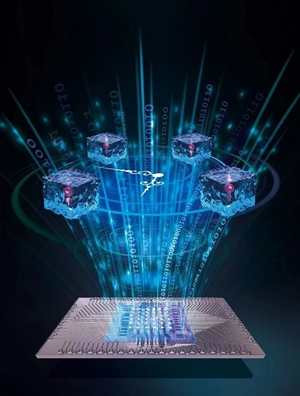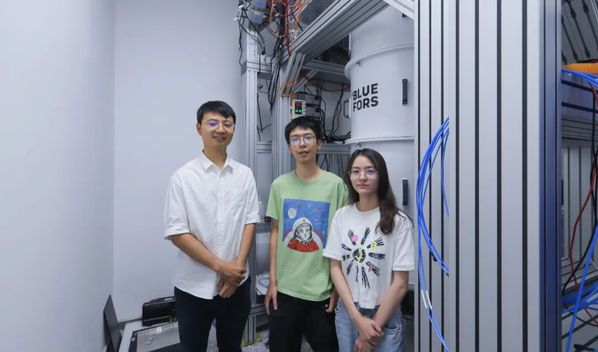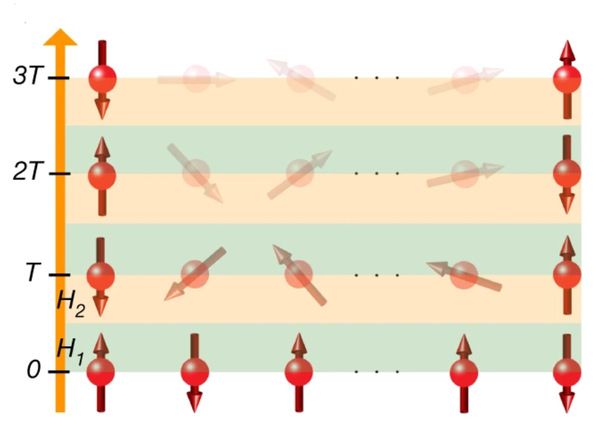Scientists realize topological time crystal using digital quantum simulation
Quantum computing is becoming a unique and potent tool on the path of human exploration into the unknown. In collaboration with Prof. DENG Dongling from the Institute for Interdisciplinary Information Sciences at Tsinghua University, Prof. WANG Zhen and Prof. WANG Haohua from the Zhejiang University School of Physics and others demonstrated a distinct state of matter—topological time crystal—via digital quantum simulation with an array of programmable superconducting qubits. This is a new non-equilibrium state of matter. The researchers observed its discrete time crystalline behavior—Floquet symmetry-protected topological phases.
Their research findings are published in a research article entitled “Digital quantum simulation of Floquet symmetry-protected topological phases” in the journal Nature.

Time crystals were first proposed theoretically by Frank Wilczek in 2012 as a time-based analogue to common crystals—whereas the atoms in crystals are arranged periodically in space, the atoms in a time crystal are arranged periodically in time. Time crystals are characterized by certain periodic variations. Just like the hands of a clock, they return to their initial position after one revolution. However, for time crystals, their periodic iteration is their natural and stable “ground state”—the state where matter has the lowest energy. You can interpret periodic variations as their “nature” like “flashing” or “breathing”. Moreover, they don’t need to consume any energy as a clock does.
In the past decade, there have emerged a series of important theoretical and experimental explorations regarding the concept of “time crystals.” In theoretical physics, scientists have proposed the concept of discrete time crystals and “created” theoretical models for time crystals in a non-equilibrium system—the quantum many-body localized system. In the experimental domain, scientists created discrete time crystals in several platforms between 2017 and 2018. In 2021, a collaboration between Google and physicists from multiple universities reported the observation of a discrete time crystal on a superconducting quantum processor with 20 qubits in the journal Nature.
Two years ago, Prof. DENG Dongling started to conceive a new type of time crystal and attempted to incorporate the concept of topology into time crystals. He collaborated with the superconducting quantum computing team at Zhejiang University to create this new type of time crystal on a superconducting quantum processor. “Regular time crystals have been realized in certain experimental platforms, and we wanted to blaze new trails. So when DENG Dongling proposed the idea of creating topological time crystal, we found it so intriguing that we wanted to try it out on our superconducting quantum computing platform,” said Prof. WANG Zhen.

Prof. WANG Zhen (left) and doctoral students ZHANG Xu and DENG Jinfeng (right) in the lab
In recent years, quantum computing has displayed unrivaled power in solving complex questions. According to Prof. WANG Zhen, we can achieve quantum computing by performing logical operations on quantum bits, also known as quantum gates. Different quantum gates are combined into different algorithmic “building blocks” which scientists can use to construct their own imaginative “architecture”. Theoretical scientists play the role of architects, designing different combinational ways.
“In general, many complex quantum ‘building blocks’ are needed to simulate the evolution of quantum many-body matter,” said JIANG Wenjie, one of the co-authors of the study from Tsinghua University, “According to the theoretical idiosyncrasy of our model, we came up with an ingenious idea of building a house with as few ‘blocks’ as possible. This way is more operable from the experimental perspective.”
Meanwhile, the research team from Zhejiang University devoted themselves to building more versatile quantum “building blocks”. “While solving a specific problem, we need to experiment with different combinations of ‘building blocks’ without swapping chips. Digital quantum simulation is a sure path to universal quantum computing, said ZHANG Xu and DENG Jinfeng, another two co-authors of the paper.
After evaluating the idea proposed by Prof. DENG Donging’s team, the Zhejiang University research team implemented the “digital quantum simulation” scheme. They used quantum circuits of depth exceeding 240 with 26 programmable superconducting qubits. This was a more universal experimental solution than analog quantum simulation. Superconducting quantum computing is marked by more programming flexibility, greater quantum gate accuracy, and a wider variety of quantum algorithms. “Our work involves a host of complex concepts, such as time crystals, topology, quantum many-body matter. It may be difficult to accomplish the simulation task using analog quantum simulation. The platform at Zhejiang University, which is universal, can thus meet our demands. Theoretically, digital quantum simulation can be applied to many studies in physics,” JIANG Wenjie said.

A chain of spins is periodically driven with the time-periodic Hamiltonian H(t), giving rise to an FSPT phase characterized by time-translational symmetry breaking at the boundaries.
ZHANG Xu described the evolution of topological time crystal in a vivid way. “This is kind of similar to a row of children wearing headphones and spinning in circles. Each child should not only spin to the rhythmic beat of the music but also complete acrobatic movements in twos and threes. Topological in nature, these specially orchestrated movements can ‘entangle’ the dances of the first and last children through quantum effects. In this way, even if the tempo of the music changes, a stable ‘tacit agreement’ can still be observed between the first and last children,” JIANG Wenjie explained, “Time crystals exhibit broken time translation symmetry. The system we create is topological, with the edges (ends) and interior of the chain showing different properties. Only at the boundaries of the chain are time translation symmetry broken.”
The successful simulation of topological time crystal is a testament to the feasibility of using digital quantum simulation on superconducting quantum processor. It will inspire people to explore more new substances and novel phenomena on the superconducting quantum computing platform. In the next step, the researchers will continue to expand the scale and performance of quantum processor to simulate quantum problems featured by newer properties, wider scales, and richer physical connotations, thereby providing a fundamental platform for the development of quantum algorithms and the exploration of their applications.
Photo credit: The research team, ZHU Yuanzhi